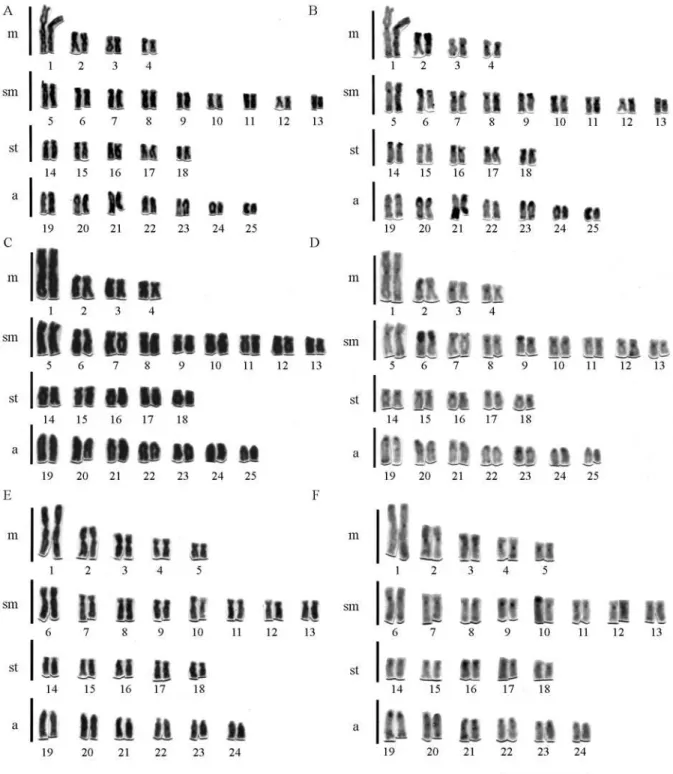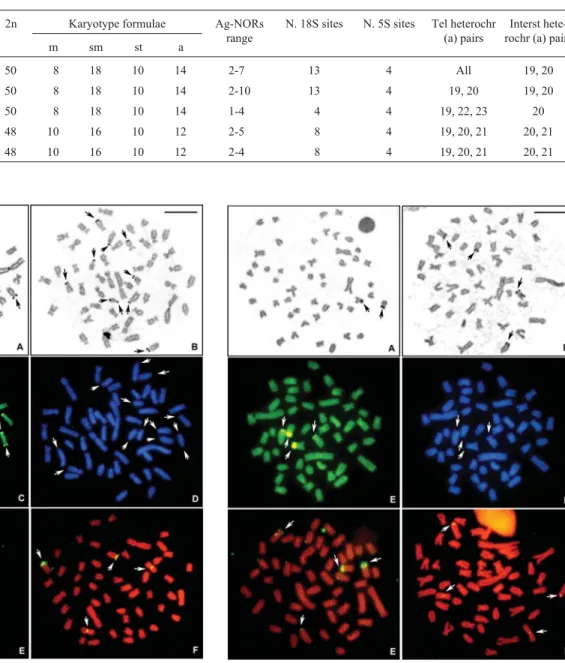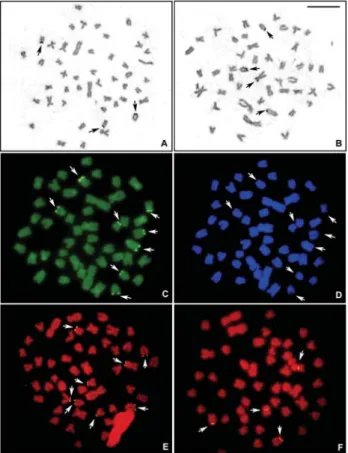Comparative cytogenetics among species of the
Astyanax scabripinnis
complex. Evolutionary and biogeographical inferences
Marcelo Ricardo Vicari
1, Rafael Bueno Noleto
2, Roberto Ferreira Artoni
1, Orlando Moreira-Filho
3and Luiz Antonio Carlos Bertollo
31
Departamento de Biologia Estrutural, Molecular e Genética, Universidade Estadual de Ponta Grossa,
Ponta Grossa, PR, Brazil.
2
Departamento de Genética, Universidade Federal do Paraná, Curitiba, PR, Brazil.
3
Departamento de Genética e Evolução, Universidade Federal de São Carlos, São Carlos, SP, Brazil.
Abstract
Karyotype data are presented for distinct species of the genusAstyanax from four rivers belonging to three different hydrographic basins of the State of Paraná, Brazil (Verde River - Tibagi basin, Açungui River - Ribeira basin, and Santo Antônio and Jaguariaíva Rivers - Jaguariaíva basin). Three karyotypic forms were identified, here denomi-nated karyotype A (2n = 50 chromosomes, with 8m+18sm+10st+14a, and thirteen 18S rDNA sites); karyotype B (2n = 50 chromosomes, with 8m+18sm+10st+14a, and four 18S rDNA sites); and karyotype C (2n = 48 chromosomes, with 10m+16sm+10st+12a, and eight 18S rDNA sites). The pattern of constitutive heterochromatin was similar among the three karyotypic forms, with few differences. The 5S rDNA corresponds to a synapomorphic character re-garding its number and chromosomal localization. The karyotypic form A occurs in the distribution center of the type locality ofA. paranae, in the proximities of the town of Castro (Tibagi basin), and may have reached the headwaters of the Ribeira River by the breakdown of geographical barriers. The karyotypic forms B and C are sympatric and syntopic, occurring solely in the Jaguariaíva River basin. Our hypothesis is that the karyotypic form A corresponds to the speciesA. paranae and forms B and C correspond to other species of the A. scabripinnis complex.
Key words:karyotype evolution, cytotaxonomy, rDNA sites, biogeography.
Received: October 19, 2006, Accepted: April 18, 2007.
Introduction
The genusAstyanaxbelongs to a group of Neotropi-cal fish widely distributed throughout Central and South America and previously placed in the subfamily Tetragonopterinae (Géry, 1977). Recently, this group was listed asincertae sedisin Characidae, due to a lack of con-sistent evidence of monophyletism (Lima et al., 2003). Thus, cytogenetical/evolutionary studies are of special in-terest inAstyanax, possibly contributing to the elucidation of the interrelationships among its species.
Based on morphological and chromosomal charac-ters, Moreira-Filho and Bertollo (1991) proposed thatA. scabripinnisshould constitute a species complex. Nowa-days, it is considered that this complex is composed by ap-proximately 15 species, includingA. paranae(Bertaco and Lucena, 2006). This species has been usually considered as
a subspecies ofA. scabripinnis(Eigenmann, 1927; Maistro
et al., 1998; Garutti and Britski, 2000), probably due to the lacks of precise diagnostic characters (Bertaco and Lucena, 2006).
The type locality ofA. paranaeis the region of Cas-tro, a city in the State of Paraná, Brazil (Eigenmann, 1914 apud Garutti and Britski, 2000). Specimens of the A. scabripinniscomplex from streams of the State of Paraná, belonging to the Tibagi basin headwaters in the proximities of Castro and to the Ribeira and Jaguariaíva basins, were analyzed in the present study. The main objective was the karyotype characterization, as well as a cytogenetic com-parison among the different samples in order to establish possible evolutionary/biogeographical relationships among them.
Material and Methods
One hundred and thirtyAstyanaxspecimens were an-alyzed: 44 specimens from the Verde River - a tributary of the Tibagi basin, in the Castro region (25° 04' 81" S and
www.sbg.org.br
Send correspondence to Marcelo Ricardo Vicari. Laboratório de Citogenética, Departamento de Biologia Estrutural Molecular e Ge-nética, Universidade Estadual de Ponta Grossa, Av. Carlos Caval-canti, 84025-900 Ponta Grossa, PR, Brazil. E-mail: vicarimr@ yahoo.com.br.
50° 04' 63" W), 17 specimens from the Açungui River - a tributary of the Ribeira de Iguape basin (25° 44' 89" S and 49° 67' 44" W), and 69 specimens from the Cerrado State Park, upstream the Santo Antônio and Jaguariaíva Rivers Jaguariaíva basin (24° 35' 42" S and 49° 25' 67" W) -(Table 1). All specimens showed characters that diagnosed the A. scabripinnisspecies complex. Testimony samples were deposited at the fish collection of the Museu de Zoolo-gia of the Universidade Estadual de Londrina, Paraná, Bra-zil (voucher numbers: MZUEL 3700, A. scabripinnis paranaefrom the Verde River; MZUEL 4064,Astyanaxsp. cf. A. scabripinnis paranae from the Açungui River; MZUEL 3702,Astyanaxsp. from the Santo Antônio Ri-ver).
Chromosome preparations were obtained from ante-rior kidney cells usingin vivocolchicine treatment (Ber-tolloet al., 1978). Constitutive heterochromatin was visual-ized by C-banding (Sumner, 1972), as well as by double fluorochrome staining using Chromomycin A3+DAPI
(Schweizer, 1980), which are indicative of GC- and AT-rich regions, respectively.
Nucleolar organizing regions (NORs) were detected using silver nitrate staining (Ag-NORs), according to Ho-well and Black (1980), and fluorescentin situhybridization (FISH) to locate the 18S rDNA sites on the chromosomes. An 18S rDNA probe (nearly 1,800 bp) generated by PCR of nuclear DNA from the fishProchilodus argenteus (Hata-naka and Galetti Jr., 2004) was used. A 5S rDNA probe from the fish Leporinus elongatus (Martins and Galetti, 1999) was employed to map the 5S rDNA sites on the chro-mosomes. Both probes were labelled with 14-dATP biotin by nick translation following the manufacturer’s instruc-tions (Bionick Labelling System - Invitrogen). The FISH signals were visualized according to Pinkelet al.(1986) and analyzed in an Olympus BX50 epifluorescence micro-scope. Chromosome images were captured using the soft-ware CoolSNAP-Pro (Media Cybernetics).
Nearly 30 metaphases per specimen were analyzed to determine the diploid chromosome number and the karyo-type structure. Chromosomes were classified as m (meta-centric), sm (submeta(meta-centric), st (subtelo(meta-centric), and a (acrocentric), according to Levanet al.(1964).
Results
Three distinct karyotypes were identified considering all the specimens analyzed, here named A, B, and C, differ-ing in the number of chromosomes and/or karyotype struc-ture.
Karyotype A
This karyotypic form showed 2n = 50 chromosomes, differentiated into 8m+18sm+10st+14a (Figure 1 A). The constitutive heterochromatin was located in the centro-meric region of all chromosomes and in the interstitial or telomeric regions of a few chromosome pairs (Figure 1 B;
Table 2). Multiple telomeric Ag-NORs were observed, with intra and inter-individual variations (Figure 2 A, B; Table 2). Thirteen 18S rDNA sites were detected by FISH, invariably in a telomeric position, with a subtelocentric chromosome presenting bitelomeric sites, i.e., NORs in both telomeres, in only one chromosome of the pair (Figure 2 E). The double CMA3/DAPI staining showed CMA3
-pos-itive and DAPI-negative signals coincident with the 18S rDNA sites (Figure 2 C, D, respectively). The 5S rDNA genes were located in the proximal region of the long arm in two chromosome pairs, one metacentric and one acrocen-tric (Figure 2 F). This karyotypic form was detected in the specimens from the Verde River (Tibagi basin) and Açun-gui River (Ribeira de Iguape basin), in the surroundings of the town of Castro. The acrocentric pair 21 was polymor-phic for the Verde River population concerning a large heterochromatic block distally located on the long arm, de-tected in a few heterozygote specimens (Figure 1 B).
Karyotype B
This karyotype also presented 2n = 50 chromo-somes, organized into 8m+18sm+10st+14a (Figure 1 C). The constitutive heterochromatin was located in the centromeric region of all chromosomes and in the intersti-tial or telomeric regions of a few chromosome pairs (Fig-ure 1 D; Table 2). Ag-NORs were also telomeric, with intra and inter-individual variations. These variations, however, were less than those found in karyotype A (Fig-ure 3 A, B; Table 2), which was also confirmed by the de-tection of only four 18S rDNA sites detected by FISH (Figure 3 E). The double CMA3/ DAPI staining showed
CMA3-positive and DAPI-negative signals in
conspicu-ous sites coincident with the 18S rDNA sites (Figures 3 C, D, respectively). The 5S rDNA genes were located in the proximal region of the long arm in two chromosome pairs, one metacentric and one acrocentric (Figure 3 F). This karyotypic form was found in the specimens from the Santo Antônio River (Jaguariaíva basin).
Karyotype C
Different from karyotypes A and B, the karyotype C presented 2n = 48 chromosomes, arranged into 10m +
Table 1- Number ofAstyanaxsamples with the karyotypic forms A, B, and C. Kar = karyotypic forms; n. f . = number of female specimens; n. m. = number of male specimens.
Rivers Kar n. f. n. m. Total
Verde A 31 13 44
Açungui A 11 6 17
Santo Antônio B 34 10 44 Santo Antônio C 13 6 19
Jaguariaíva C 0 6 6
16sm+ 10st + 12a (Figure 1 E). The constitutive hetero-chromatin was located in the centromeric region of all chro-mosomes and in the telomeric regions of a few chromo-some pairs, besides chromo-some conspicuous interstitial bands in acrocentric chromosomes (Figure 1 F). Multiple telomeric Ag-NORs were also observed, with intra and inter-indi-vidual variations from two to five sites (Figure 4 A, B; Ta-ble 2). Nevertheless, eight 18S rDNA sites were detected by FISH, always in telomeric positions (Figure 4 E). The
double CMA3/DAPI staining showed CMA3-positive and
DAPI-negative signals in conspicuous sites coincident with the 18S rDNA sites (Figures 4 C, D, respectively). The 5S rDNA genes were located near the centromeric region of the long arm in two chromosome pairs, one metacentric and one acrocentric (Figure 4 F). This karyotypic form was found in the Jaguariaíva River population, also occurring in sympatry and syntopy with karyotype B in the Santo Antô-nio River (Jaguariaíva basin).
Discussion
The diploid chromosome number 2n = 50 was the most frequent one, found in three out the four studied sam-ples (Verde, Açungui, and Santa Antônio Rivers). Indeed, the chromosome number 2n = 50 was also observed in the majority of the populations belonging to theA. scabripinnis
species complex (Moreira-Filho and Bertollo, 1991; Man-tovaniet al., 2000; Neoet al., 2000; Maistroet al., 2000;
Ferroet al., 2001; Maistroet al., 2001; Moreira-Filhoet al., 2001; Ferroet al., 2003).
Although the 2n = 50 karyotypes have similar macro-structures (8m+18sm+10st+14a), with just few variations in the distribution and localization of the heterochromatin, it was possible to differentiate them into two distinct forms concerning the 18S rDNA sites: karyotype A, found in the specimens from Verde and Açungui Rivers, is character-ized by thirteen 18S rDNA sites, two of which located in both telomeres of the same chromosome (bitelomeric
Table 2- Karyotype data ofAstyanaxfrom the Verde River (Tibagi basin), Açungui River (Ribeira basin), Santo Antônio River (Jaguariaíva basin), and Jaguariaíva River. Kar = karyotypes; Tel heterochr (a) pairs = telomeric heterochromatin in acrocentric pairs; Interst heterochr (a) pairs = interstitial heterochromatin in acrocentric pairs.
Rivers Kar 2n Karyotype formulae Ag-NORs range
N. 18S sites N. 5S sites Tel heterochr (a) pairs
Interst hete-rochr (a) pairs m sm st a
Verde A 50 8 18 10 14 2-7 13 4 All 19, 20
Açungui A 50 8 18 10 14 2-10 13 4 19, 20 19, 20 Santo Antônio B 50 8 18 10 14 1-4 4 4 19, 22, 23 20 Santo Antônio C 48 10 16 10 12 2-5 8 4 19, 20, 21 20, 21 Jaguariaíva C 48 10 16 10 12 2-4 8 4 19, 20, 21 20, 21
Figure 2- Metaphases of the karyotypic form A (Astyanax paranae) evi-dencing (A, B) the Ag-NOR bearing chromosomes; (C) Chromomycin A3
positive or GC-rich sites; (D) sequential DAPI negative or AT-negative sites; (E) the 18S rDNA sites, and (F) the 5S rDNA sites. Bar represents 10µm.
Figure 3- Metaphases of the karyotypic form B (unidentified species of theAstyanax scabripinnisspecies complex) evidencing (A, B) the Ag-NOR bearing chromosomes; (C) Chromomycin A3positive or GC-rich
NORs); and karyotype B, found in the specimens from Santo Antônio River, characterized by presenting four 18S rDNA sites (Table 2). A third karyotypic form - karyotype C - is characterized by the presence of a smaller diploid number (2n = 48 chromosomes), a differentiated karyo-typic formula (10m+16sm+10st+12a), and eight 18S rDNA sites. Specimens bearing this karyotype were found in the Jaguariaíva River, besides its sympatric and syntopic oc-currence with specimens with the karyotype B in the Santo Antônio River (Table 2).
The comparative analysis of karyotypes B (2n = 50) and C (2n = 48) of the specimens from the Santo Antônio River suggests that they probably maintain a homeology of their chromosome pairs, except for the absence of two chro-mosome pairs (1 sm and 1 a) and the presence of a large metacentric pair (pair 2) in karyotype C. The morphologi-cal similarity indicates that the metacentric pairs 1, 2, 3, and 4 of the karyotypes A and B must be homeologous to pairs 1, 3, 4, and 5 of the karyotype C, respectively. Thus, the metacentric pair 2 of the karyotype C (2n = 48) may have originated through a translocation event between two small chromosomes, one submetacentric and one acrocentric, from a karyotype with 2n = 50 chromosomes.
The occurrence of 2n = 48 chromosomes has already been described for some specimens of theA. scabripinnis
complex from the Upper Paraná River basin (Moreira-Filho and Bertollo, 1991; Souzaet al., 1996; Mizoguchi and Mar-tins-Santos, 1998; Maistroet al., 2000; Mantovaniet al., 2000; Alves and Martins-Santos, 2002). Besides the diploid number, they generally also differ from specimens with 2n = 50 chromosomes by a differentiated subtelocentric pair (Mantovaniet al., 2000) or a submetacentric pair (Maistroet al., 2000). However, none of those 2n = 48 specimens pre-sented a metacentric chromosome pair such as the number 2 of the karyotype C. Therefore, the karyotypic form C (2n = 48) from the Jaguariaíva basin would be more closely related to the karyotypic form B (2n = 50) of this same basin than to the otherAstyanaxof thescabripinniscomplex with 2n = 48 chromosomes (Mantovaniet al., 2000; Maistroet al., 2000). None of the sympatric specimens of the Santo Antonio River presented a hybrid karyotypic formula, suggesting a proba-ble reproductive isolation between forms B and C. Further-more, small differences in the localization of the heterochro-matin blocks in the acrocentric chromosomes, as well as the occurrence of a distinct number of 18S rDNA sites (Table 2), agree with the possible existence of two different taxa. These data also suggest a model of allopatric speciation between these two karyotypic forms that would have become sympatric after the breakdown of geographical barriers, as is also proposed for a few other species of theA. scabripinnis
complex (Souzaet al., 1995; Maistroet al., 2000).
Multiple Ag-NORs were observed, but with numeri-cal variations between the distinct karyotypic forms. The 18S rDNA sites were always located in the telomeric re-gions of the chromosomes, in accordance with the Ag-NORs. The double staining by the GC- and AT-specific fluorochromes, chromomycin A3and DAPI, respectively,
showed GC-positive and AT-negative signals coincident with the 18S rDNA sites. The occurrence of a subtelo-centric chromosome with bitelomeric NORs was verified only in the specimens with karyotype A. This feature, cou-pled with the higher number of NORs, reinforces a close phylogenetic relationship between the two samples with this karyotypic form,i.e., the specimens from Verde River (Tibagi basin) and Açungui River (Ribeira de Iguape ba-sin). A possible vicariant event by “headwater captures” (term used to designate the incorporation of the headwaters of a given river into another river belonging to an adjacent hydrographic basin), could explain the karyotype conserva-tiveness among the specimens of these two adjacent hydro-graphic basins, with only few differences in heterochro-matin distribution (Table 2), probably resulting from the current gene flow restriction. This model of headwater cap-tures and gene flow restriction is also applicable to other fish species from these same basins, as is the case of
Hoplias malabaricus(Vicariet al., 2005), andGeophagus brasiliensis(Vicariet al., 2006), and also has been used to explain the sympatric occurrence of differentCharacidium
Figure 4- Metaphases of the karyotypic form C (unidentified species of theAstyanax scabripinnisspecies complex) evidencing (A, B) the Ag-NOR bearing chromosomes; (C) Chromomycin A3positive or GC-rich
species (Centofanteet al., 2001). Our proposition is in ac-cordance with Ribeiro (2006) who considers that the Ponta Grossa Arch represents the most prominent geological fea-ture in the region of Paranapanema, Iguaçu, and Ribeira de Iguape headwaters and stated that “the tectonic activity of the Ponta Grossa Arch could have resulted in a particular accelerated fluvial dynamism between adjacent drainage systems, accelerating the faunal exchange between them”. 5S rDNA sites were found in a conserved location, proximally to the centromere of two chromosome pairs, one metacentric and one acrocentric, in all sampled speci-mens. The maintenance of these two chromosome pairs with 5S rDNA sites in the same position was also verified in otherAstyanaxspecies, as well as in other species of theA. scabripinniscomplex (Ferroet al., 2001; Almeida-Toledo
et al., 2002; Mantovaniet al., 2005), Nevertheless, some
Astyanaxspecies with only one chromosome pair bearing 5S rDNA sites were already described, such as A. altiparanae(Fernandes and Martin-Santos, 2006), andA. janeiroensis(Vicari, unpublished data), evidencing a prob-able synapomorphic feature among the species with two chromosome pairs bearing 5S rDNA.
The karyotype data here presented are important tools for the taxonomy of theAstyanaxspecies. In this sense, our proposal is that the karyotypic form A corresponds toA. paranae, since it is found in the center of the distribution of its type locality, in the Castro region (Tibagi basin) and reaching, through breakdown of geological barriers, the headwaters of the Ribeira de Iguape basin. On the other hand, the karyotypic forms B and C, found in the Jaguariaí-va basin, which are cytogenetically differentiated between themselves and from the form A, although morphologically similar, can represent other species belonging to the A. scabripinnisspecies complex and, if so, indicating that the number of species in this complex is subestimated.
Acknowledgments
The authors are grateful to IAP (Instituto Ambiental do Paraná) and IBAMA (Instituto Brasileiro do Meio Am-biente) for authorizing the specimen captures (IBAMA/ MMA No. 02017.000686/00-21). This work was supported by FAPESP (Fundação de Amparo à Pesquisa do Estado de São Paulo - proc. no03/13019-0), CNPq (Conselho Nacio-nal de Desenvolvimento Científico e Tecnológico), and Fundação Araucária (Fundação Araucária de Apoio ao De-senvolvimento Científico e Tecnológico do Estado do Paraná). We also thank Dr. Oscar A. Shibata for assistance in the taxonomy of the specimens, and Miguel Airton Carvalho for collaboration in field and laboratory activities.
References
Almeida-Toledo LF, Ozouf-Costaz C, Foresti F, Bonillo C, Porto-Foresti F and Daniel-Silva MFZ (2002) Conservation of the 5S-bearing chromosome pair and co-localization with
major rDNA clusters in five species of Astyanax (Pisces, Characidae). Cytogenet Genome Res 97:229-233.
Alves AL and Martins-Santos IC (2002) Cytogenetics studies in two populations of Astyanax scabripinnis (Pisces, Characidae) with 2n = 48 chromosomes. Cytologia 67:117-122.
Bertaco VA and Lucena CAS (2006) Two new species of Astyanax (Ostariophysi, Characiformes, Characidae) from eastern Brazil, with a synopsis of theAstyanax scabripinnis species complex. Neotrop Ichthyol 4:53-60.
Bertollo LAC, Takahashi CS and Moreira-Filho O (1978) Cyto-taxonomic considerations on Hoplias lacerdae (Pisces, Erythrinidae). Braz J Genet 1:103-120.
Centofante L, Bertollo LAC and Moreira-Filho O (2001) Compar-ative cytogenetics among sympatric species ofCharacidium (Pisces, Characiformes). Diversity analysis with the descrip-tion of a ZW sex chromosome system and natural triploidy. Caryologia 54:253-260.
Eigenmann CH (1927) The American Characidae. Part 4. Mem Mus Comp Zool 43:311-428.
Fernandes CA and Martins-Santos IC (2006) Mapping of the 18S and 5S ribosomal RNA genes inAstyanax altiparanae Ga-rutti & Britski, 2000 (Teleostei, Characidae) from the upper Paraná river basin, Brazil. Genet Mol Biol 29:464-468. Ferro DAM, Moreira-Filho O and Bertollo LAC (2001) Nucleolar
organizing regions, 18S and 5S rDNA in Astyanax scabripinnis(Pisces, Characidae): Populations distribution and functional diversity. Genetica 110:55-62.
Ferro DAM, Moreira-Filho O and Bertollo LAC (2003) B chro-mosome polymorphism in the fishAstyanax scabripinnis. Genetica 119:147-153.
Garutti V and Britski HA (2000) Descrição de uma nova espécie deAstyanax(Teleostei, Characidae) da bacia do Alto Paraná e considerações sobre as demais espécies do gênero na bacia. Comum Mus Ciênc PUCRS 13:65-88.
Géry J (1977) Characoids of the World. T.F.H. Publications, Nep-tune City, 672 pp.
Hatanaka T and Galetti Jr PM (2004) Mapping of the 18S and 5S ribosomal RNA genes in the fish Prochilodus argenteus Agassiz, 1829 (Characiformes, Prochilodontidae). Genetica 122:239-244.
Howell WM and Black DA (1980) Controlled silver staining of nucleolus organizer regions with a protective colloidal de-veloper: A 1-step method. Experientia 36:1014-1015. Levan A, Fredga K and Sandberg AA (1964) Nomenclature for
centromeric position on chromosomes. Hereditas 52:201-220.
Lima FCT, Malabarba LR, Buckup PA, Silva JFP, Vari RP, Har-old A, Benine R, Oyakawa OT, Pavanelli CS, Menezes NA et al.(2003). GeneraIncertae Sedisin Characidae. In: Reis RE, Kullander SO and Ferraris Jr CJ (eds) Check List of the Freshwater Fishes of South and Central America. Edipucrs, Porto Alegre, pp 106-169.
Maistro EL, Oliveira C and Foresti F (1998) Comparative cytoge-netic and morphological analysis ofAstyanax scabripinnis paranae (Pisces, Characidae, Tetragonopterinae). Genet Mol Biol 21:201-206.
Maistro EL, Oliveira C and Foresti F (2001) Cytogenetic charac-terization of a supernumerary chromosome segment and of B-chromosomes in Astyanax scabripinnis (Teleostei, Characidae). Genetica 110:177-183.
Mantovani M, Abel LDS, Mestriner CA and Moreira-Filho O (2000) Accentuated polymorphism of heterochromatin and nucleolar organizer regions inAstyanax scabripinnis (Pis-ces, Characidae): Tools for understanding karyotypic evolu-tion. Genetica 109:161-168.
Mantovani M, Abel LDS and Moreira-Filho O (2005) Conserved 5S and variable 45S rDNA chromosomal localization re-vealed by FISH in Astyanax scabripinnis (Pisces, Characidae). Genetica 123:211-216.
Martins C and Galetti Jr PM (1999) Chromosomal localization of 5S rDNA genes in Leporinus fish (Anostomidae, Characiformes). Chrom Res 7:363-367.
Mizoguchi SMHN and Martins-Santos IC (1998) Cytogenetic and morphometric differences in populations of Astyanax “scabripinnis”(Pisces, Characidae) from Maringá region, PR, Brazil. Genet Mol Biol 21:55-61.
Moreira-Filho O and Bertollo LAC (1991)Astyanax scabripinnis (Pisces, Characidae): A species complex. Brazil J Genet 14:331-357.
Moreira-Filho O, Fenocchio AS, Pastori MC and Bertollo LAC (2001) Occurrence of a metacentric macrochromosome B in different species of the genusAstyanax(Pisces, Characidae, Tetragonopterinae). Cytologia 66:59-64.
Néo DM, Bertollo LAC, Moreira-Filho O and Camacho JPM (2000) Altitudinal variation for B chromosome frequency in
the characid fish Astyanax scabripinnis.Heredity 85:136-141.
Pinkel D, Straume T and Gray JW (1986) Cytogenetic analysis us-ing quantitative, high-sensitivity, fluorescence hybridiza-tion. Proc Natl Acad Sci USA 83:2934-2938.
Ribeiro AC (2006) Tectonic history and the biogeography of the freshwater fishes from the coastal drainages of eastern Bra-zil: An example of faunal evolution associated with a diver-gent continental margin. Neotrop Ichthyol 4:225-246. Schweizer D (1980) Simultaneous fluorescent staining of
R-bands and specific heterochromatic regions (DAPI R-bands) in human chromosomes. Cytogenet Cell Genet 27:190-193. Souza IL, Moreira-Filho O and Bertollo LAC (1995) Cytogenetic
diversity in theAstyanax scabripinnis(Pisces, Characidae) complex. II. Different cytotypes living in sympatry. Cytolo-gia 60:273-281.
Souza IL, Moreira-Filho O and Galetti Jr PM (1996) Hetero-chromatin differentiation in the characid fish Astyanax scabripinnis. Braz J Genet 3:405-410.
Sumner AT (1972) A simple technique for demonstrating centro-meric heterochromatin. Exp Cell Res 75:304-306.
Vicari MR, Artoni RF and Bertollo LAC (2005) Comparative cytogenetics ofHoplias malabaricus(Pisces, Erythrinidae): A population analysis in adjacent hydrographic basins. Genet Mol Biol 28:103-110.
Vicari MR, Artoni RF, Moreira-Filho O and Bertollo LAC (2006) Basic and molecular cytogenetics in freshwater Cichlidae (Osteichthyes, Perciformes). Karyotypic conservationism and divergence. Caryologia 59:260-266.
Associate Editor: Cláudio Oliveira



